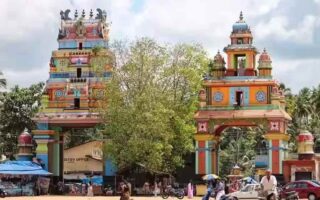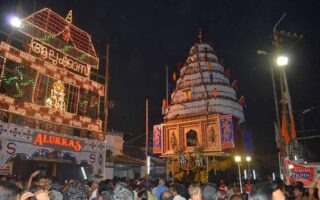- Location: Kottayam in Kerala
- Main Deity/Deities: Lord Shiva
- Major Attraction: A grand festival
- Timings: 3:30 AM to 9:00 PM
- Entry Fee: No entry fee
Vaikom Temple is among the most sacred temples of Kerala which are dedicated to Lord Shiva. Closely associated with two other temples, namely, Kaduthuruthy Mahadeva and Ettumanoor temples, the worship at this temple is believed to fulfill any desire of the devotee. Located at a distance of 40 kilometers from Kottayam, the temple is famous for its architectural beauty.

Architecture of the Temple
As you enter the temple premises, you will be astonished to see a magnificent courtyard that is stretched over an area of 8 acres. The entrances are through four Gopurams that are present on four sides. Vyaghrapada Sthana of the temple is the place near eastern entrance which is of immense sacred importance to the devotees. It is believed that saint Vyaghrapada performed a holy pooja over here and got to have the glimpse of the deities Shiva and Parvati.
As you go inside, you will get to see a golden flagstaff adoring the premises of Vaikom Temple. As you go further, a sacrificial stone is seen where a sculpture of Ganesha is present. In the interior of Namaskaram Mandapa, you will see the illustrations from Ramayana adoring the roof of the place. At this sacred place, Margazhi and Dravya Kalash Puja are performed. You can also hear chanting of Vedic hymns here. In the eastern direction, a charming sculpture of the bull Nandi is installed. An inner way will take you to a sacred yard or Sreekovil of Shree Vaikkathappan whose worship is supposed to grant wishes of the devotees.
Sreekovil: Built in circular shape and adorned with sheets of copper, Sreekovil of Vaikom Temple has two chambers. Mukha Mandapa which is constructed in the shape of a bull is worth watching. It is made up of wood and stone. On the other hand, the second chamber or Garbhagriha is built entirely in stone. A huge platform that is located in the center of Garbhagriha houses a fascinating Shivalingam of Shree Vaikkathappan. This huge structure is made up of black stone. The lingam appears quite lively as it is decorated with eyes, hand, nose etc. You will get enthralled at the scene of a multitude of ghee lamps lighting the place.
Six Steps: You will not be able to have the glimpse of the holy Saiva Chaitanya unless and until you traverse six steps from the Gopuram. These six steps have religious significance as they are considered symbols of the six emotions of life including Lobha, Krodha, Kama, Moha, Mathsarya, and Madha.
Going the south east direction, you will come across idols of Maha Ganapathy and Sakthy Ganapathy. Another significant place is Mathrumala which is famous among the devotees for the presence of sacred stones from Mathas. You would witness an old Vilwa tree present in the vayu cone of Sreekovil. Manya Sthana of Vaikom Temple also carries religious significance as it is he place at which Vaikkathappan was seen eating food.
In addition, there is a sacred kitchen near Manya Sthana; here food items are prepared. It is believed that people have seen here Lord preparing food for the temple.
History Behind the Closed Door
In olden days, the temple was under the dispute between two groups who used to at loggerheads for acquiring the ownership rights of the place. Njallal Namboothiri form one of the groups entered Nivedya in ordered to disrupt the pooja ceremony. He threw betel remains form his mouth into the Nivedya. He was punished on the spot as he died by a snake bite. According to some people, the door closed automatically then and a voice was heard by them which ordered never to open the door again.
Legend of the Lingam
A legend is associated with the shivalingam of the temple. Kharasura worshipped Lord Shiva in order to do penance for his deeds. As Lord got pleased, Kharasura was rewarded with three lingams by him. Shiva told him that he would always be present in them. Khara took two lingams in his hands and carried the third one on his neck. As he placed these on the ground and tried to pick them again after some time, he failed to do so. Khara, having understood it a miracle of the Lord, worshipped the lingams. After attaining moksha, he entrusted these to Maharishi Vyaghrapada.
Important Customs of the Temple
Most important custom that is followed with full reverence at Vaikom Temple is Sandhya Vela. It is followed by the recitals of hymns of Vedas. A special procession is carried out. There are different types of Sandhya Velas that are observed here. Another special feature is offering coin and is observed by Brahmans who present each other with a coin in evening. These coins become part of the treasure. The cooking of food items is also the responsibility of Brahmins. The oil required for cooking is brought by Cherthala Samooha.
Festivals
The festival of Ashtami is celebrated with full enthusiasm. The celebrations are carried out for 12 days in the month of November or December. A colorful procession of the deities for the nearby temples at night is the main feature of this particular festival. This is followed by the procession of the deity of this temple. A present offering ceremony is important part of Ashtami. The celebrations end with Arattu.
Weather
Vaikom experiences a tropical climate, typical of the Indian state of Kerala. The weather here is characterized by high temperatures and significant humidity. The town receives rainfall during the monsoon season, which can extend from June to September. The best time to visit Vaikom Sree Mahadeva Temple would be during the cooler and drier months.
Best Time to Visit
The ideal time to plan a visit to Vaikom Sree Mahadeva Temple is from October to March. During this period, the weather is relatively cooler and more comfortable for exploring the temple complex and its surroundings. The monsoon season, which can be hot and wet, is best avoided. This window also aligns with several important festivals and celebrations at the temple, making it an excellent time to experience the local culture and traditions.
How to Reach
Vaikom is well-connected by road, and you can reach the town via various modes of transportation.
By Air
The nearest major airport is Cochin International Airport, which is approximately 60 kilometers away from Vaikom. From the airport, you can hire a taxi or use other local transport options to reach the temple.
By Train
Kottayam Railway Station is the closest railway station to Vaikom, located around 30 kilometers away. Regular trains connect Kottayam to major cities in India. From the railway station, you can hire a cab or take a bus to Vaikom.
By Road
Vaikom is well-connected by road, and you can reach it by bus or car. State and private buses run services to Vaikom from nearby towns and cities, including Kottayam and Kochi. You can also hire a taxi or use a ridesharing service for more convenience.
Distance from Major Cities
- Kottayam to Vaikom: Approximately 30 kilometers
- Kochi to Vaikom: Approximately 46 kilometers
- Cochin International Airport to Vaikom: Approximately 64 kilometers
- Thiruvananthapuram to Vaikom: Approximately 180 kilometers
Plan your visit during the pleasant months of October to March to enjoy your trip to Vaikom Sree Mahadeva Temple to the fullest, and don’t forget to explore the temple’s rich history and the cultural heritage of the region.
FAQs
Q-1: Is photography allowed inside the temple premises?
Yes, photography is generally allowed, but it’s important to be respectful and not disrupt ongoing rituals.
Q-2: Can non-Hindus visit the temple?
Yes, the temple is open to people of all faiths, but visitors are expected to adhere to the temple’s customs and traditions.
Q-3: Are there any accommodation options near the temple?
Yes, there are various hotels and guesthouses in Vaikom that offer comfortable stay options.
Q-4: What is the significance of the temple’s sacred pond?
The sacred pond, known as ‘Pushkarni,’ is believed to have healing properties, and a dip in its waters is considered spiritually cleansing.
Q-5: How can one participate in the temple’s festivals and pujas?
Information about festival schedules and special pujas can be obtained at the temple office or from the temple priests.


